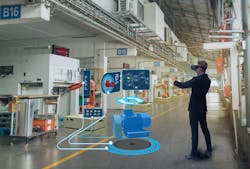To make matters more complicated, electrical control cabinets typically integrate hundreds of terminal blocks and related accessories. All those parts are linked by dedicated compatibility rules and specific functions (depending on the application). So, terminal block design is an under-appreciated yet complex process. Fortunately, with some additional CAD software tools, design engineers can simplify the selection process and help ensure they’re taking the optimal approach to integrating terminal blocks in their electrical control panel. This type of software allows designers to create 2D and 3D tower block assembly drawings so that they can visualize the project more easily. Some terminal block manufacturers even offer these CAD software tools free of charge.
Best practices for optimizing electrical cabinet design
If you’re trying to make your terminal block design process go more smoothly, here’s what to look for when choosing a CAD tool to integrate terminal block design:
Look for an interface that’s simple to use — ideally one that all project stakeholders can understand. A simple interface makes it easier to communicate technical specs, which saves time and makes the project more efficient. Ideally, the interface is intuitive enough that a non-specialist could use it to create advanced outputs, manage multiple projects, and create detailed drawings. A good tool will make it simple to generate 2D and 3D markings, export to other CAD systems, and generate the technical file with production drawing, parts list, technical data, and more.Look for software with pre-assembled and pre-marked terminal blocks. Instead of installing each terminal block one-by-one on the rail, look for a CAD tool that incorporates a complete set of terminal blocks pre-mounted on the rail, pre-marked, equipped with the right accessories, and ready to be installed into the panel. Some components suppliers make this software available to design engineers, who particularly appreciate the time savings that a pre-completed set provides. This option also enables designers to better manage production costs by reducing the manufacturing steps (because there’s less assembly operation) and incorporating quality control within the supplier’s tool. In addition, designers can also receive support from a components expert.Look for software that includes a 3D parts download platform. Designers who use their own CAD resources (mechanical CAD for equipment layout purposes) must be able to quickly and easily access the 3D model they want to use. It is much easier to import and use this model if it is available in the native CAD format. Fortunately, some components providers offer high-powered software platforms for downloading 2D and 3D models free of charge. This allows the designer to access complete parts catalogs, generate online models in the desired formats, and import the 3D model into the project.Look for an import and export interface between the electrical CAD and the terminal block assembly design software.Designers use electrical CAD software to create the electrical circuit diagram of a cabinet. But electrical CAD platforms are designed for global project planning, and don’t offer a high level of detail or comprehensive rules dedicated to terminal block assembly. For example, the diagram generated will be basic, showing only the rail, the terminal blocks, and a few simple accessories. To get the level of detail necessary to create a comprehensive bill of materials (BOM), some components suppliers provide an import/export interface that allows for more specialized terminal block assembly. With the interface, detail can be added to the drawing using compatible accessories and drilling plans, and corrections can be made on the fly. Then, once that step is finalized, an accurate BOM can be re-imported into the CAD to supplement the project’s main BOM. At the same time, the user can retrieve the complete technical file for the terminal block assembly.Making software work harder for you
Since terminal blocks are housed in the electrical panel, they’re subject to the same challenges and requirements that modern panels face, including demands for:
- Reduced panel size
- Greater functionality and performance
- Reduced energy consumption
Add to this the very real challenges engineers face on most projects — the push to be more productive and develop faster as well as the need to be agile and responsive to changes in specs/requirements as the project progresses — and you can see why design engineers are looking for ways to optimize the process and gain more efficiency. Thankfully, with a few CAD software tools, designers can optimize their productivity when integrating terminal blocks into the panel.
Vincent Menager is a technical and training specialist with TE Connectivity. He can be reached at [email protected].





